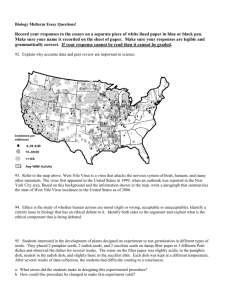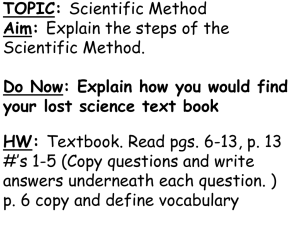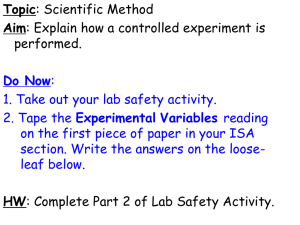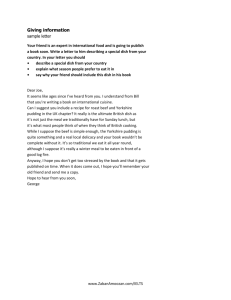Independent variable
advertisement
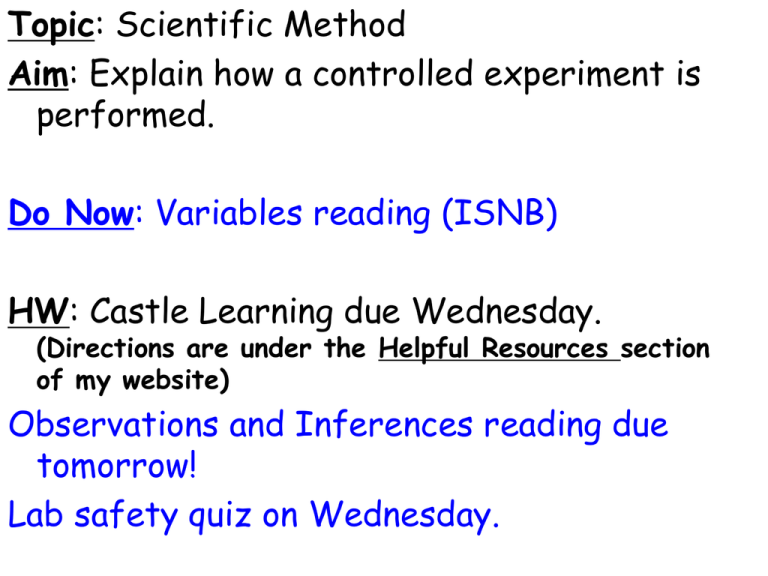
Topic: Scientific Method Aim: Explain how a controlled experiment is performed. Do Now: Variables reading (ISNB) HW: Castle Learning due Wednesday. (Directions are under the Helpful Resources section of my website) Observations and Inferences reading due tomorrow! Lab safety quiz on Wednesday. www.castlelearning.com Let’s summarize… Identify the improper lab procedure observed in the diagram. Let’s summarize… Identify the improper lab procedure observed in the diagram. Does fertilizer X help plant growth? • 2 groups: Parts of a controlled 1.Experimental group: contains the experiment independent VARIABLE 2.Control group: DOES NOT contain the independent variable Control Group Experimental Group 2 types of 1. Independent variables Variable: the 1 factor that’s different between experimental and control groups Independent variable = ? SUNLIGHT 2. Dependent Variable = what is MEASURED (data) HEIGHT Height = 12 cm Height = 21 cm How do we make the results of an experiment more reliable/valid/ accurate? • Repeat experiment • Use a larger sample size Let’s summarize… 1. Explain the difference between the control and experimental groups. 2. Explain the difference between the independent and dependent variables. 3. How can the results of an experiment be more accurate? Experiment 1. What is the independent variable? 2.What is the dependent variable? 3.Explain the difference between the control group and experimental groups in this experiment. An investigation was done with an electromagnetic system made from a battery and wire wrapped around a nail. Different sizes of nails were used. The number of paper clips the electromagnet could pick up was measured. Independent variable: • Sizes of nails • These were changed by the scientist Dependent variable: • Number of paper clips picked up Let’s summarize… Identify the improper lab procedure observed in the diagram. Let’s summarize… Identify the improper lab procedure observed in the diagram. Which statement is true about the experimental group (s) in an experiment? a. It does not contain the independent variable. b. It contains 2 variables. c. It contains the independent variable. d. It is exactly the same as the control group. Review: To investigate how temperature affects seed germination, a student placed 10 radish seeds of the same variety on moist paper in each of 3 petri dishes and placed the dishes in the following environments: Dish # 1: Refrigerator, 5ºC Dish # 2: Room Temperature, 20ºC Dish # 3: Incubator, 37ºC 1. Which factor is the variable in this investigation? a. temperature b. kind of seeds c. moisture d. number of seeds To investigate how temperature affects seed germination, a student placed 10 radish seeds of the same variety on moist paper in each of 3 petri dishes and placed the dishes in the following environments: Dish # 1: Refrigerator, 5ºC Dish # 2: Room Temperature, 20ºC Dish # 3: Incubator, 37ºC 2. The control group is a. Dish #1 b. Dish #2 c. Dish #3 3. The dependent variable is the a. temperature b. how many days till germination c. The # of seeds d. the amount of water What is the factor in an experiment that remains constant? a. control b. variable c. theory d. hypothesis 6. The results of one experiment carried out by a research team would be considered valid if a. the experiment had no control setup b. all the members of the research team came to the same conclusion c. the experiment had more than one variable d. the experiment was repeated and the same results were obtained each time An investigation was done with an electromagnetic system made from a battery and wire wrapped around a nail. Different sizes of nails were used. The number of paper clips the electromagnet could pick up was measured. Independent variable: • Sizes of nails • These were changed by the scientist Dependent variable: • Number of paper clips picked up The higher the temperature of water, the faster an egg will boil. • Independent variable? • temperature of water • Dependent variable? • time to cook an egg Beta-carotene supplements have been thought to protect against cancer. A study was conducted with 39,000 women aged 45 and up. Group A received a beta-carotene supplement. Group B received a placebo. Their health was studied over their lifetime. Cancer rates for women taking the beta-carotene supplement did not really differ from the cancer rates of those women taking the placebo. Identify the independent variable, dependent variable, control group, and experimental group. Ex # 2: To investigate the effect of a substance on plant growth, 2 bean plants of the same species were grown under identical conditions with Substance Z added to the soil of one of the plants. At the end of 2 weeks, the plant grown with Substance Z was 12.5 cm tall. The plant grown without Substance Z was 12.2cm tall. The researcher concluded that the presence of Substance Z causes the plants to grow taller. What is the independent variable? Substance Z What is the dependent variable? height Which setup is the control? Plant without Substance Z Ex #3: A student placed 5 geranium plants of equal size in 5 environmental chambers. Growing conditions were the same for each plant except for the amount of water each received. At the end of 20 days, the width of the leaves was measured. What is the independent variable? What is the dependent variable? Which setup is the experimental group? 5. An investigation was designed to determine the effect of ultraviolet light on mold spore growth. Two groups of mold spores were grown under identical conditions, except one group was exposed only to ultraviolet light, while the other group was grown in total darkness. In this investigation, the group of mold spores grown without receiving any ultraviolet light is known as the a. experimental variable b. hypothesis c. control d. limiting factor Watch the video about lab safety rules. http://www.youtube.com/watch?v=tsAHt0 FiwNM&feature=related Review: The first step in the scientific method is a. to state the problem b. experimentation c. to state the hypothesis d. observation An educated guess to the problem of an experiment is known as a a. variable b. theory c. hypothesis d. law When performing an experiment, you are testing the a. problem b. hypothesis c. data d. conclusion Your senses can be used to make a(n) a. observation b. conclusion c. hypothesis d. problem
